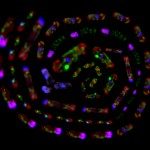Lien vers Pubmed [PMID] – 16730849
Trends Genet. 2006 Jul;22(7):375-87
Hemiascomycetous yeasts have the greatest number of sequenced species for a single phylum, and are at the forefront of evolutionary genomics of eukaryotes. Yeast genomes show the dynamic interplay between the formation and loss of genes and help to characterize the mechanisms involved and their functional and evolutionary consequences. These mechanisms have equivalents in the genomes of multicellular organisms. Yeast genomes show extensive loss of introns and a reduced role of transposable elements, and so probably have a more limited potential to form novel genes and functions than multicellular organisms, possibly explaining their conserved biological and morphological properties despite their considerable evolutionary range.

